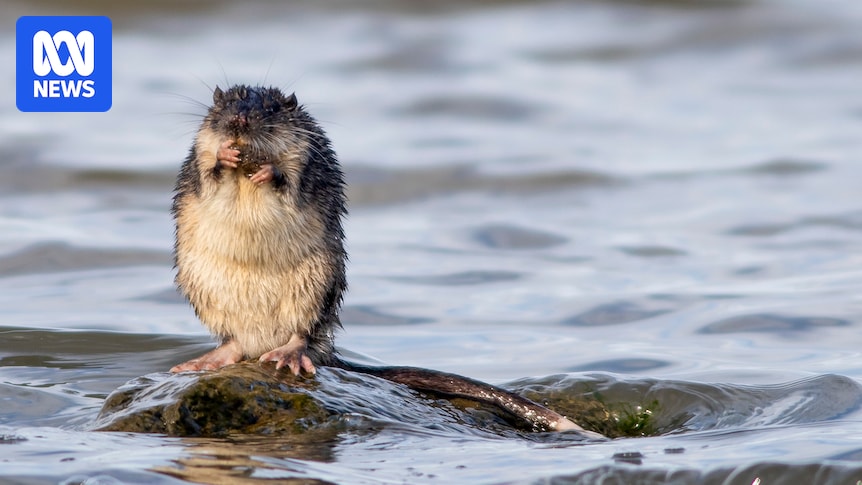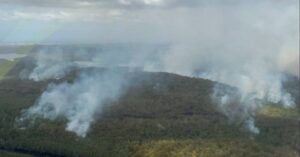
Whether it’s hunting invasive pests or gliding through rivers like an otter, the rakali (Hydromys chrysogaster) is a beloved yet often overlooked native species in Australia. This adaptable creature, known as the nation’s largest rodent, has thrived in urban, mountainous, and coastal habitats across the country. Recently, the rakali was crowned Australia’s most underrated animal in the ABC’s National Science Week poll, a recognition that surprised even some experts.
Antia Brademann, a researcher monitoring rakali at Bush Heritage Australia’s Scottsdale Reserve, south of Canberra, expressed her astonishment at the poll results. “As a rakali fanatic myself, I wasn’t sure the Australian public would respond to the call to elect a rat as our most underrated animal,” she remarked. “But right around the country, people have spoken, and the rakali is finally getting its moment in the spotlight — proof that being a furry little water ninja with webbed feet and a taste for cane toads pays off.”
The Rakali’s Unique Adaptations
Dr. Ann Jones, host of What The Duck?! on ABC Radio National, supports the rakali’s newfound fame. “The rakali is worthy of this crown. It is more than a rat — it is the ruler of all the rats,” she said. “It’s widespread but secretive, it’s fluffy but a kick-arse fighter, it surprises and delights observers, and its very presence repels introduced black rats out of its territory.”
While it may resemble a large rat at first glance, the rakali is distinguished by its white-tipped tail and, in most of its habitat range, yellow belly fluff. This characteristic is even reflected in its scientific name, “chrysogaster,” meaning “golden belly” in ancient Greek. The rakali’s diet is diverse, primarily consisting of shellfish, fish, and other aquatic animals, but it has also been known to catch birds that venture too close to the water.
Coexistence and Competition
The rakali can coexist in the same habitats as the platypus, yet it has adapted more successfully to degraded environments, such as urban waterways, than the duck-billed monotreme. Charles Sturt University ecologist Emmalie Sanders noted the rakali’s resilience: “They’re resilient, they’re everywhere, they don’t need a great deal, they can survive in pretty low-quality water,” she said.
Wildlife Warriors Against Invasive Species
A recent study published in Australian Mammalogy highlighted the rakali’s role as a natural deterrent to feral rats in some areas. The study documented an ambush of an invasive black rat in Sydney by a rakali, captured on a camera trap. Like the polarising ibis, the rakali has learned to consume invasive and toxic cane toads without harm.
“[Rakali] can sense prey moving with their whiskers,” Sanders explained. “They usually manage to flip [toads] and consume them from the belly where they don’t have those poisonous glands.”
Rakali have survived the fur trade and a rebranding effort. In the early 1900s, during a Bubonic plague outbreak, a bounty was placed on rats to curb disease spread, leading to some rakali being killed. Known as the “beaver-rat,” their water-repellent coats were collected in the 1930s when imported furs were banned, causing the price of rakali fur to rise significantly.
A Cultural and Scientific Rebranding
The rakali underwent a significant rebranding in 1995, spearheaded by the Australian Nature Conservation Agency (now Parks Australia), to change its name from “water rat” to “rakali,” the Indigenous name used by the Ngarrindjeri people from the lower Murray River in South Australia. This name change coincided with the fictional TV crime show Water Rats, which focused on Sydney’s water police. Today, the name rakali is widely recognized, though the species is known by many Indigenous names across the country.
Genetic Diversity and Historical Insights
Genetic studies have enhanced our understanding of rakali populations and their origins. Rodents first arrived in Australia about 5 million years ago, but rakali have been present for approximately 1 million years. Tasmania hosts the oldest rakali lineage, possibly representing the earliest spread of the species from New Guinea. Significant genetic divergence exists between populations from Tasmania, southwest Western Australia, Barrow Island, and the east coast.
Rakali from Barrow Island have silver-grey coats, while those in southwest WA are mostly black, and golden-bellied morphs dominate the eastern states.
Despite their long history in Australia, rodents, including rakali, do not receive the same reverence as marsupials. This is despite about one-third of the country’s 60 rodent species facing extinction or significant population declines since European colonization.
Protecting the Rakali
There is still much to learn about the rakali, including whether any distinct populations are at risk of extinction. Sanders hopes to uncover more about the species’ plight, though tracking rakali poses challenges. “They’ve been difficult to track,” she said. “[In] any radio-tracking studies that are done, they are notoriously good at getting out of their little collars that we put the transmitters on.”
Meg Shaw, an environmental behavior researcher at Monash University, suggests several measures to protect rakali locally. “One of the key threats to rakali is being entangled in fishing line and nets, so you can actually report sightings of illegal fishing nets to CRIMFISH, or there are other authorities within your state,” she advised. “They are also predated on by dogs, cats, and foxes, so the recommendations are to try and keep cats and dogs away from waterways where rakalis could be.”
Finally, Shaw emphasized the importance of driving slowly around rakali habitats, particularly at night when they are more active and harder to see.






